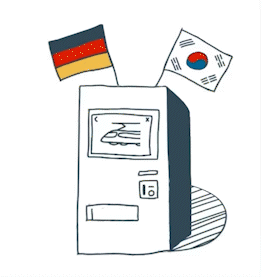
Embedding Cultures into UX Design
A master thesis on UX design for empowering a better coherence and cohesion between different cultures.
< OTHER UX DESIGN WORKS

Why?
Finding a solution for cultural differences through design
The collision of cultural values is the everlasting challenge of global society that needs to be resolved as humanity takes its lightning step into the age of globalisation. UX design is also under this influence.
UX design is linked to user values

UX design is all about user value. And the user value differs fundamentally from culture to culture.
Human mental programmes, mind-sets and core values are different across cultures. UX design is developed around the cornerstone of such psychological values of its target groups.
Hence, designers need to be conscious of such diverse cultural values when developing cross-cultural experience so that they can achieve satisfactory usability.
What?
Design process for multiple cultural groups requires an extensive approach.
Interactive kiosk

Interactive kiosks such as ticket machines and ATMs are locally owned but have a high proportion of international customers. Research through design with interactive kiosks shape the thesis and participants from two cultures, Germany and South Korea, engage in the research.
Cross-cultural Diamond Process
A new Double Diamond Process is presented. It also includes an empirical demonstration of how to bring intangible pleasure to both cultures through an understanding of value in subjective depth.
As a result, this study presents a new direction on how to effectively yield encouraging outcome from cross-cultural designs.

1. Cultural compromise of globalised design
General design
The general design is defined based on the mental model of the users of both cultures, the compromise on their different expectations and the international standard ISO. The value of each cultural group is determined through in-depth user research.
Cognitive psychology
Each unit is developed according to cognitive psychology, e.g., recall memory, subconscious, short-term memory, and Gestalt theory, which apply to all humankind regardless of culture.








2. Cross-cultural pictogram system
Pictograms create bridges of understanding. It's a big advantage that mental models and subconscious knowledge can be called up.
Active participation of the users
Participants in the two cultural groups were given task sheets, where they interpreted and drew their own pictograms for each term used in train ticket machines.
The collected drawings were compared between the cultures and the one that had the highest similarities with each other was selected and reconstructed.






3. Interactive elements
Visual hierarchy, Consistency, Affordance, magical number seven, etc, interactive elements are constructed based on cognitive psychology. It is valid for every mankind, irrespective of culture.
Their size is no smaller than 44x30 px, according to MIT Touch Lab research and Clark&Frost.


4. Cross-cultural Diamond Process
This thesis demonstrates the process of developing UX designs for two different cultural groups.
Why new Diamond Process ?
The Double Diamond Process from Design Council is a pioneer of the traditional UX design process and has been playing an active part in various UX design projects across the world. But the two cultural groups in the study were those without cultural connection to each other, so their issues differed fundamentally.
Therefore, a broader scale of penetrating user research and a comparison of the results were necessary.
So the idea of the existing Double Diamond process was adopted, and the Cross-cultural Diamond Process was developed, transforming it into a new approach.
CONSOLIDATE
DELIVER
Usability tests should be conducted iteratively with users from both cultural groups to evaluate the design and implement ability of services that have not yet been specified.
DEFINE
Designers define unique problems and backgrounds of each cultural group and pinpoints where the focus needs to be. It is a process of prioritisation in order to focus on higher value areas.
Simultaneously, a point of confluence or a junction is created between the two diamonds by comparing the two aspects. Minimising disagreements and seeking the most suitable compromise are key.






5. Attributes and its depth
of UX design
for cross-cultural target groups
To better understand the design process in designing cross-cultural experiences, it is necessary to take a closer look at the different impact depths of design.

Finding universal solution
The strength of cross-cultural design lies in finding universal solution rather than in personalisation.
A perfect solution for one small target group can lead to negative consequences like confusion or offence to a broader target group.
Depth and precision can therefore be achieved only with a small target group that moves within a consistent range of values. For cross-cultural design, however, the more universal approach is the core process.

What is universal solution ?
In order to understand the different levels of human imprinting that designers can access as a resource of inspiration and user understanding, these are divided into categories and represented graphically.
The search for a universal solution requires human nature and basic knowledge.
Human nature is the cognitive psychology that we all share, basic knowledge is the mental model that humanity has in the modernised world, such as technological knowledge.
Cultural values of a particular cultural target group are not applicable to cross-cultural design, nor can personal values.
The classification is essentially based on Geert Hofstede's descriptions.




Created at

im Bereich Interaction Design
Examiners:
Prof. Stefan Wölwer
Shaohua Pan

















